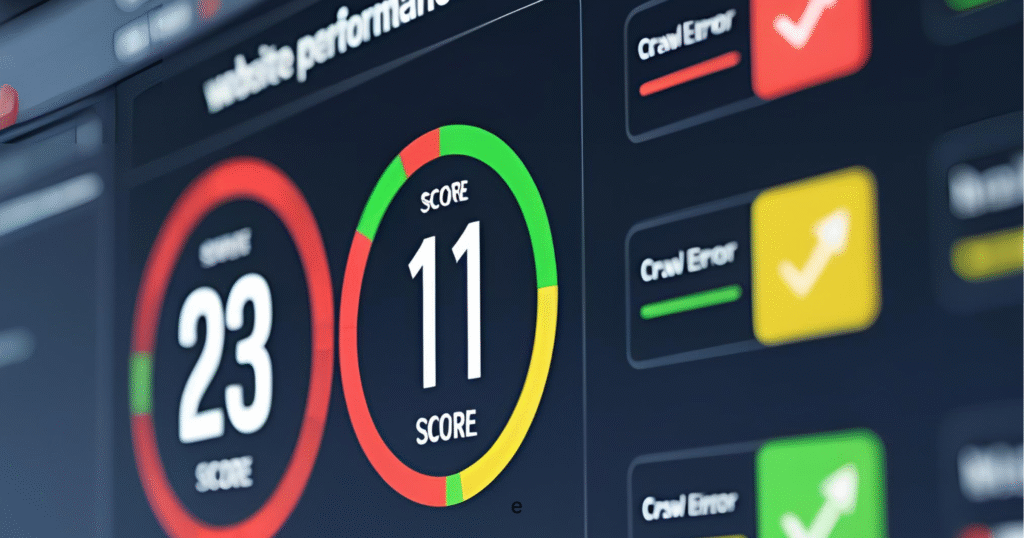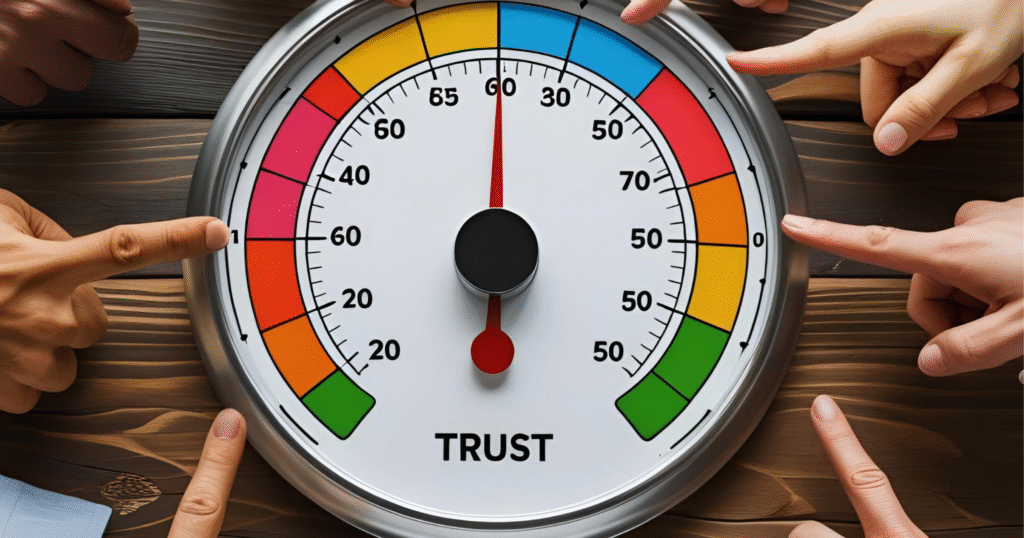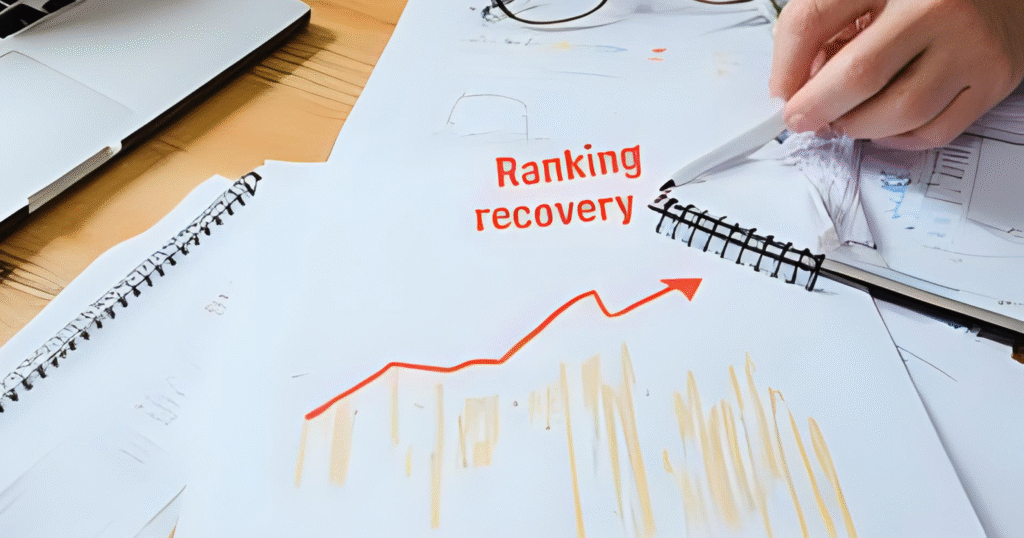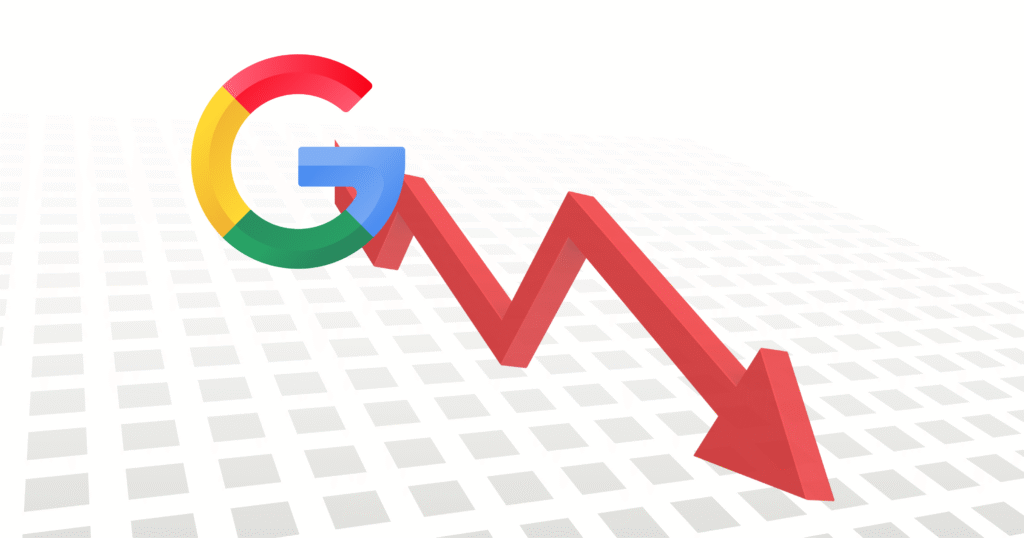You wake up, check your traffic… and it’s gone. Now you wonder how to recover lost Google rankings
The blog post that used to rank #3 is now buried on page 5. Your homepage is slipping. Leads are slowing down. Panic mode? Not yet.
Losing Google rankings is more common than you think even for seasoned marketers and high-quality sites. But here’s the good news: it’s also fixable.
In this guide, you’ll learn exactly how to recover lost Google rankings using a proven 5-step method we call The Ranking Recovery Loop™ designed to diagnose the real cause, take targeted action, and restore your visibility faster.
How to Figure Out Why Your Google Rankings Dropped

Before you fix anything, you need to know what went wrong. If your traffic suddenly dipped or your best blog post disappeared from search, don’t just start guessing. That’s how people waste time.
Instead, let’s look at real data.
Start with Google Search Console. It’s free and gives you clues like which pages lost traffic, what keywords fell, and if there were any indexing issues. If you don’t have it set up yet, do that today. No excuses.
Then check Google Analytics to see when the drop started. Did it happen overnight? Was it slow and steady? That tells us whether it’s something technical or content-related.
If you have access to tools like Ahrefs, SEMrush, or even Ubersuggest, they can show you lost backlinks, keyword changes, or competitor moves.
You’re not just a content creator — you’re a detective now. Find the signs. They’re all there if you know where to look.
Once you’ve figured out what’s broken, you’re ready to start the fix.
How to Recover Lost Google Rankings After an Algorithm Update
Sometimes your content is great… but Google changes the rules.
If your rankings dropped right after a major update, it’s probably not your fault. Google rolls out changes to how it ranks content several times a year. Some updates focus on content quality. Others look at user experience or spam.
To know for sure, check sites like Search Engine Roundtable or Moz’s Google Update History. Match the date of your traffic dip with any known updates. If there’s a match, you’ve likely been hit.
But don’t panic.
Here’s what to do:
- Read Google’s guidance about the update. They often hint at what changed.
- Look at your content. Is it helpful, accurate, and trustworthy? That’s what Google wants now.
- Compare your page with the top-ranking ones. What are they doing that you aren’t?
Sometimes, small changes can make a big difference — like adding missing details, improving formatting, or making it easier to skim.
The goal here is not to chase the algorithm, but to realign your content with what Google (and users) now expect.
How to Refresh Content and Recover Lost Google Rankings

If your blog post used to rank high but slowly faded, the content itself might be the problem. Not because it’s bad but because it’s outdated, thin, or no longer matches what searchers want.
This is called content decay, and it’s one of the top reasons rankings drop silently over time.
Here’s what to do:
- Update old facts or stats
Make sure your data is current and relevant for 2025. Search engines love fresh, accurate info. While refreshing your content, don’t just update words think about how to keep readers engaged longer. One way is by adding stronger calls to action, like we shared in this blog post “Convert Blog Readers into Email Subscribers in 2025” - Add more value
Look at the top 3 competitors on Google for that topic. What are they including that you’re not? Add those details — but do it better. - Improve formatting
Break long paragraphs into scannable chunks. Use clear subheadings. Add quotes, examples, or short videos if needed. - Include internal links
Link to other pages on your site that are related. It helps Google understand the context and boosts the page’s authority.
Refreshing your content doesn’t mean rewriting from scratch. It means tightening it up, improving clarity, and showing Google that your content is still alive and relevant.
How to Fix Technical SEO Issues That Kill Google Rankings
Sometimes it’s not your content that’s the problem , it’s your site’s structure behind the scenes.
Even one small technical error can send your rankings crashing. And the worst part? Most business owners don’t know where to look.
Here’s how to check if technical issues are dragging you down:
- Run a site audit using free tools like Google Search Console, PageSpeed Insights, or Screaming Frog. They’ll show you if you have slow load times, broken links, or crawl errors.
- Check your site speed — especially on mobile. Google now ranks mobile performance before desktop. If your site is slow, visitors bounce. And when they bounce, Google drops you.
- Fix broken internal links and redirect chains. These confuse search engines and make it harder to crawl your site.
- Make sure your site is secure (HTTPS). If you’re still using HTTP, you’re sending trust signals in the wrong direction.
- Optimize images by compressing file size and using proper alt text. Big, slow images hurt your load time and your rankings.
Think of this step like cleaning your house before guests arrive. You might have great content, but if the foundation is messy, nobody wants to stay.
How to Rebuild Trust and Recover Lost Google Rankings

Rebuilding trust also means showing what makes you different. In this article, we shared how to position your brand so you stand out in a crowded market.
Google doesn’t just rank pages , it ranks trust. If your rankings dropped, it might be because your page no longer looks trustworthy enough.
Let’s fix that.
Start with E-E-A-T: Experience, Expertise, Authoritativeness, and Trust. Google wants to rank content written by people who know what they’re talking about, especially in niches like finance, health, or business.
Here’s how to rebuild trust:
- Add author bios with real credentials. If you’re an expert or work with one, say it proudly.
- Include updated sources and link to reputable websites. Show Google you did your homework.
- Use HTTPS, clean design, and zero spammy ads. Trust is also about how your site feels to visitors.
- Get backlinks from reputable sources. If high-authority sites trust you, Google is more likely to do the same.
- Use real examples, testimonials, or case studies. Not only does this help SEO, it also helps your readers believe you.
Rebuilding trust isn’t just about rankings — it’s about becoming the go-to source in your industry. That’s what Google rewards.
How to Future-Proof Your Content and Protect Google Rankings in 2025
Fixing your rankings is great but keeping them high is even better.
Google’s algorithm is always changing, but there are things you can do now to make sure your content stays visible no matter what update rolls in.
Here’s how to stay ahead:
- Keep your content fresh. Revisit important pages every 3 to 6 months. Add new stats, examples, or insights. Make it feel alive.
- Match user intent, not just keywords. Ask: what is someone really trying to do when they search this? Then give them exactly that.
- Use original visuals, videos, or graphics. These not only boost engagement, they help you stand out from the copy-paste crowd.
- Get feedback. Ask your audience what’s unclear or missing. Turn comments into updates. The more useful your content becomes, the harder it is to outrank.
- Build authority around a niche. Don’t try to rank for everything. Own your space — whether it’s remodeling, home services, or SaaS. Depth wins.
If you treat your content like a living asset — not a one-time task — you’ll not only recover rankings… you’ll future-proof them.
Recover Lost Google Rankings and Keep Your Traffic Growing

Losing rankings can feel like a major setback but it doesn’t have to be the end of your growth.
Now you know how to recover lost Google rankings using a method that actually works. You’ve learned how to find the problem, fix the content, clean up technical issues, rebuild trust, and stay ahead of updates.
This isn’t just theory. It’s what smart, growing businesses do to stay visible online — month after month.
And if you’d rather not figure it all out alone?
👉 Let’s do the heavy lifting for you: Get a free SEO review here
Let’s turn those lost rankings into your next big win.


